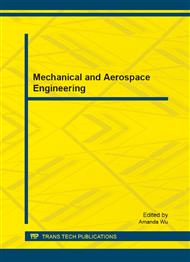[1]
T. C Robert, J. L Alan, and K. Takeo, Introduction to the Special Edition on Video Surveillance, Proceedings of the IEEE Transactions on Pattern Analysis and Machine Intelligence, Volume 22, No. 8, pp.745-757, August (2000).
Google Scholar
[2]
M. Harville, G. Gordon, and J. Woodfill, Foreground Segmentation using adaptive mixture models in color and depth, In Proceedings of the IEEE workshop on Detection and Recognition of Events in Video, (2001).
DOI: 10.1109/event.2001.938860
Google Scholar
[3]
M. Akhloufi, and A. Bendada, Thermal Faceprint: A new thermal face signature extraction for infrared face recognition, 2008, pp.269-272.
DOI: 10.1109/crv.2008.43
Google Scholar
[4]
P. Buddharaju, I. Pavlidis, and P. Tsiamyrtzis, Pose-invariant physiological face recognition in the thermal infrared spectrum, 2006, p.53.
DOI: 10.1109/cvprw.2006.160
Google Scholar
[5]
M. M. Khan, M. Ingleby, and R. D. Ward, Automated Facial Expression Classification and affect interpretation using infrared measurement of facial skin temperature variations, in ACM.
DOI: 10.1145/1152934.1152939
Google Scholar
[6]
J. Wilder, P. Phillips, C. Jiang et al., Comparison of visible and infra-red imagery for face recognition, 2002, pp.182-187.
Google Scholar
[7]
F. J. Prokoski, History, current status, and future of infrared identification, in Proceedings of the IEEE Workshop on Computer Vision Beyond the Visible Spectrum: Methods and Applications, Washington, DC, USA, 2000, p.5.
DOI: 10.1109/cvbvs.2000.855245
Google Scholar
[8]
B. Fasel, and J. Luettin, Automatic facial expression analysis: a survey, in Pattern Recognition, 2003, pp.259-275.
DOI: 10.1016/s0031-3203(02)00052-3
Google Scholar
[9]
I. Pavlidis, J. Levine, and P. Baukol, Thermal imaging for anxiety detection, 2002, pp.104-109.
Google Scholar
[10]
I. Pavlidis, and J. Levine, Thermal facial screening for deception detection, 2002, pp.1143-1144.
Google Scholar
[11]
M. Harville, G. Gordon, and J. Woodfill, Foreground Segmentation using adaptive mixture models in color and depth, In Proceedings of the IEEE workshop on Detection and Recognition of Events in Video, (2001).
DOI: 10.1109/event.2001.938860
Google Scholar
[12]
I. T. Joliffe. Principal Component Analysis. Springer-Verlag, (1986).
Google Scholar
[13]
P. Banerjee and S. Sengupta, Human Motion Detection and Tracking for Video Surveillance, Proceedings of the national Conference of Communications, IIT Bombay, Mumbai, India, p.88–92, (2008).
Google Scholar
[14]
P. Viola and M.J. Jones, Robust real time face detection, Int. J. Comput. Vision, vol. 57, no. 2, p.137–154, (2004).
Google Scholar
[15]
R. Lien hart and J. Maydt, An extended set of haar-like features for rapid object detection, , in Proceedings of the 2002 International Conference on Image Processing (P. of the 2002 International Conference on Image Processing, ed), vol. 1, p.900–903, (2002).
DOI: 10.1109/icip.2002.1038171
Google Scholar
[16]
K. Fukunaga and W. Koontz. Application of the Karhunen-Loeve expansion to feature selection and ordering. IEEE Trans. Communications, 19(4), (1970).
DOI: 10.1109/t-c.1970.222918
Google Scholar
[17]
H. Murase and S. Nayar. Detection of 3D objects in cluttered scenes using hierarchical eigenspace. Pattern Recognition Letters, 18(4), April (1997).
DOI: 10.1016/s0167-8655(97)00017-2
Google Scholar
[18]
M. Turk and A. Pentland. Face recognition using eigenfaces. In Proceedings of Computer Vision and Pattern Recognition, (1991).
DOI: 10.1109/cvpr.1991.139758
Google Scholar
[19]
J. Karhunen and J. Joutsensalo. Generalization of principal component analysis, optimization problems and neural networks. Neural Networks, 8(4), (1995).
DOI: 10.1016/0893-6080(94)00098-7
Google Scholar
[20]
D. Lee and S. Seung. Learning the parts of objects by non-negative matrix factorization. Nature, 401, (1999).
DOI: 10.1038/44565
Google Scholar
[21]
R. Fergus, P. Perona, and A. Zisserman. Object class recognition by unsupervised scale-invariant learning. In Proceedings of Computer Vision and Pattern Recognition, June (2003).
DOI: 10.1109/cvpr.2003.1211479
Google Scholar
[22]
Hui Kong, Xuchun Li, Jian-Gang Wang and Chandra Kambhamettu, Ensemble Learning for Face Recognition,. The International Conference on Biometrics Authentification (ICBA), Hong Kong, (2006).
Google Scholar
[23]
Yu-Long Qiao; Jeng-Shyang Pan; Sheng- He Sun, Improved K nearest neighbor classification algorithm, Circuits and Systems, 2004. Proceedings. The 2004 IEEE Asia-Pacific Conference on , vol. 2, no. pp.1101-1104 vol. 2, 6-9 Dec. (2004).
DOI: 10.1109/apccas.2004.1413076
Google Scholar
[24]
Bin Zhang, Sargur N. Srihari, Fast k- Nearest Neighbor Classification Using Cluster-Based Trees, IEEE Transactions on Pattern Analysis and Machine Intelligence , vol. 26, no. 4, pp.525-528, April, (2004).
DOI: 10.1109/tpami.2004.1265868
Google Scholar


